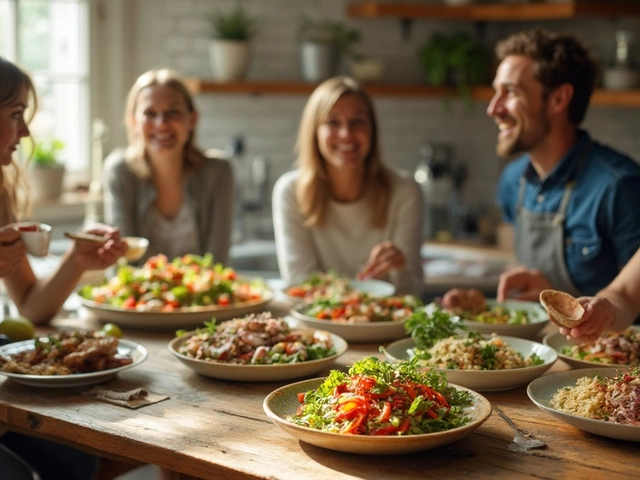
When you’re cutting carbs, you don’t need to guess what’s safe to eat. Some foods have literally zero carbs - not 1 gram, not 2, but zero. That’s rare, but it exists. And knowing exactly which ones are truly carb-free can make or break your low-carb or keto diet.
True zero-carb foods are animal-based
There’s no plant food that has zero carbs. Even leafy greens like spinach or kale have trace carbs - about 1 gram per cup. But animal products? They’re your only real shot at zero carbs. Meat, fish, eggs, and pure fats are naturally free of carbohydrates because animals don’t store carbs like plants do.
Take beef. A 100-gram serving of raw ground beef (80% lean) has 0 grams of carbs. Same with chicken breast, pork chops, lamb, and turkey. No sugar, no starch, no fiber - just protein and fat. The same goes for seafood: salmon, cod, shrimp, and tuna all have 0 grams of carbs per 100 grams. Even butter, lard, and tallow are carb-free. They’re pure fat, extracted from animals, with no plant sugars mixed in.
What about eggs?
Eggs are one of the most misunderstood zero-carb foods. A large egg has 0.6 grams of carbs - so technically not zero. But for practical purposes, it’s considered zero-carb in low-carb circles. That’s because the carb count is so low, it doesn’t register on your daily total unless you’re eating 10+ eggs a day. Most keto dieters count eggs as zero-carb. If you’re tracking macros strictly, round it down. If you’re just trying to avoid sugar and starch, eggs are safe.
Why plant foods can’t be zero-carb
Plants make carbs to store energy. Even the lowest-carb veggies like lettuce, cucumber, or zucchini still have fiber and sugars. Fiber is technically a carb, even if it doesn’t spike blood sugar. So while you can eat unlimited leafy greens on keto, they’re not zero-carb. You’re just getting so few net carbs (total carbs minus fiber) that it doesn’t matter. But if you’re looking for true zero carbs - meaning zero total carbohydrates - plants don’t qualify.
What about dairy?
Dairy is tricky. Milk has lactose - a natural sugar. A cup of whole milk has 12 grams of carbs. That’s too high for most low-carb diets. But hard cheeses? They’re different. During aging, bacteria eat up most of the lactose. A 1-ounce serving of cheddar has 0.4 grams of carbs. That’s close enough to zero for most people. Same with Parmesan, Swiss, and blue cheese. Cream cheese? About 1 gram per ounce. Butter? Zero. Heavy cream? 0.5 grams per tablespoon. So while dairy isn’t all zero-carb, some of it is close enough to count as zero in daily tracking.

Zero-carb doesn’t mean zero calories
Just because something has no carbs doesn’t mean you can eat unlimited amounts. Fat and protein still have calories. A pound of butter has zero carbs but over 3,600 calories. Eating too much of anything - even zero-carb food - can stall weight loss or push you into a calorie surplus. That’s why portion control still matters, even on a zero-carb diet.
Zero-carb meal examples
Here are real meals you can eat today with zero carbs:
- Grilled salmon with a pat of butter
- Beef steak fried in tallow, served with a side of bacon
- Scrambled eggs cooked in butter, with a slice of cheddar cheese
- Chicken thighs roasted with olive oil and rosemary
- Shrimp sautéed in ghee with garlic
These meals have no sugar, no flour, no grains, no fruit, no starchy vegetables. Just meat, fat, and eggs. You can eat them every day and stay under 2 grams of carbs - even under 1 gram if you’re careful.
What to avoid
Don’t fall for labels that say “low-carb” or “keto-friendly.” Many packaged foods - like sugar-free jerky, protein bars, or “low-carb” sauces - sneak in maltodextrin, dextrose, or modified starch. Always check the nutrition label. If it says “Total Carbohydrates: 0g,” then it’s truly zero-carb. If it says “0g Net Carbs,” that’s a red flag. Net carbs aren’t regulated. That label could hide 5 grams of sugar alcohols or fillers.
Also avoid flavored oils. Some “garlic-infused olive oil” or “lemon-infused butter” have added sugars or starches to preserve flavor. Stick to plain, unflavored fats. Same with spices - check for anti-caking agents. Pure salt, pepper, and herbs are safe. Pre-mixed seasonings? Often contain dextrose.

Can you survive on zero-carb foods only?
Yes. Some people follow a zero-carb diet for months or years. They eat only meat, eggs, and animal fat. No vegetables, no fruit, no dairy. It’s extreme, but it works for some. Studies show it can improve insulin sensitivity, reduce inflammation, and help with autoimmune conditions. But it’s not for everyone. Long-term, you might miss out on certain vitamins and fiber. Most people do better with a low-carb diet that includes leafy greens and low-sugar veggies. Zero-carb isn’t a requirement - it’s a tool.
Zero-carb doesn’t mean keto
Keto is about getting your body to burn fat for fuel. That usually means keeping carbs under 20-50 grams per day. You don’t need zero carbs to be in ketosis. A few grams from greens or cheese won’t kick you out. But if you’re sensitive to carbs, or you’re trying to reset insulin resistance, zero-carb foods give you a clean slate. They remove all doubt.
Think of zero-carb foods as your foundation. Build your meals around them. Add a little cheese, a spoon of heavy cream, or a handful of spinach if you want. But when you’re unsure - go back to meat, eggs, and butter. That’s the safest bet.
Where to buy zero-carb foods
Stick to the perimeter of the grocery store. That’s where you’ll find fresh meat, fish, eggs, and butter. Avoid the middle aisles - that’s where the packaged “low-carb” traps live. Buy whole, unprocessed foods. If it comes in a box, bag, or bottle, read the label. If you can’t pronounce the ingredients, skip it.
Local butchers and farmers markets are your best friends. You’ll get meat with no additives, eggs from pasture-raised hens, and butter with no preservatives. It costs more, but you’re paying for purity - not marketing.
Zero-carb is not a diet - it’s a filter
You don’t have to eat only zero-carb foods forever. But knowing which ones are truly carb-free gives you control. When you’re craving something, ask: “Is this zero-carb?” If yes, you can eat it without guilt. If no, you decide if it’s worth the carb cost. That’s how you stay consistent.
Zero-carb foods are simple. They don’t need recipes. You don’t need to count net carbs or calculate macros. Just cook them. Eat them. Feel better.
Can you eat cheese on a zero-carb diet?
Yes, but not all cheese. Hard cheeses like cheddar, Parmesan, and Swiss have less than 0.5 grams of carbs per ounce, so they’re considered zero-carb for practical purposes. Soft cheeses like cream cheese or brie have around 1 gram per ounce - still low, but not zero. Avoid processed cheese slices or spreadable cheeses - they often contain starch or sugar.
Do eggs have carbs?
A large egg has about 0.6 grams of carbs. That’s so low that most people on low-carb diets count it as zero. If you’re eating 2-3 eggs a day, it won’t affect your carb total. But if you’re eating 10 eggs daily and tracking strictly, you might want to count it.
Are vegetables zero-carb?
No. All vegetables contain some carbohydrates - even spinach or celery. Leafy greens have very low net carbs (1-2 grams per cup), but they still have total carbs from fiber and natural sugars. True zero-carb foods are only animal products: meat, fish, eggs, and pure fats like butter or lard.
Can you lose weight eating only zero-carb foods?
Yes. Many people lose weight on a zero-carb diet because it removes sugar, grains, and processed foods - the main drivers of fat storage. Without carbs, your body switches to burning fat for fuel. But weight loss still depends on calories. Eating too much fat or protein can slow progress. Portion control matters, even on zero-carb.
What’s the difference between zero-carb and keto?
Keto means keeping carbs under 20-50 grams per day to enter ketosis. Zero-carb means eating foods with literally zero grams of carbs. You can be on keto without eating zero-carb foods - you just need to stay under your carb limit. Zero-carb is a stricter version of keto. It’s not necessary, but it removes all uncertainty.
Is butter really zero-carb?
Yes. Pure butter, made from cream and nothing else, has 0 grams of carbs per tablespoon. Avoid flavored butters or spreads labeled "light" - they often contain milk solids or additives with carbs. Stick to salted or unsalted butter with one ingredient: cream.





